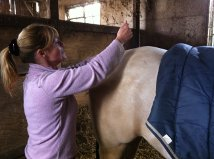BASIC STRETCHES
Horses naturally stretch and in normal circumstances do not overstretch themselves. Regular stretching will benefit your horse as it improves the tone of muscle fibres and the elasticity of ligaments and joint capsules. Benefits include:-
-
Relaxation
-
Reduced muscle stiffness and overall muscle tension
-
Reduced muscle, tendon and ligament strains
-
Increased circulation of both blood and lymph fluid, nutrition and removal of toxins
- Increased elasticity of the muscles, ligaments and tendons
- Inproved co-ordination, proprioception, stride length, range of movement and flexibility
HOW TO STRETCH
-
Always stretch when the horse is warm as muscles, tendons and ligaments risk damage if stretched when cold
-
Ask your vet or therapist which stretches should be performed
-
Begin slowly and gradually increase the stretch over several days. When stretching hold the stretch for at least 5 seconds to allow fibres to relax before asking for a little more stretch
- Try to build stretching work into your normal routine
- You will only see the benefits of stretching if you continue to perform stretches at least twice weekly and for 3 month
THE MAJORITY OF STRETCHES SHOW BELOW HAVE BEEN PERFORMED BY A 20 YEAR OLD RETIRED GRADE A BELGIUM WARMBLOOD THAT STILL PERFORMS WELL IN SHOWJUMPING AND DRESSAGE AS WELL AS HACKING OUT FOR FUN
MID NECK STRETCH
Aims
-
To encourage the horse to stretch the lateral mid neck muscles
-
Very helpful for horses that tend to carry their neck in a set position
How to perform the exercise
-
Using a treat such as a carrot, encourage the horse to bend his neck to the side so that his nose is level with the shoulder
-
If the carrot is taken back too far the base of the neck will be stretched rather than the mid neck muscles
-
Gradually increase the stretch over several days
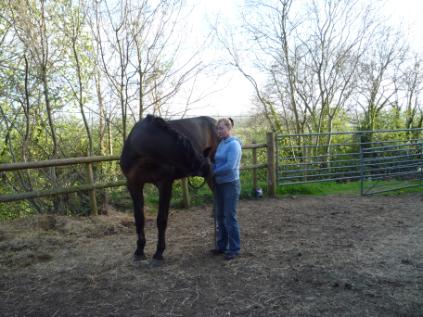
LATERAL FLEXION OF THE NECK
Aims
-
To stretch the mid region of the neck and shoulder muscles
-
Helps to prevent stiffness in the base of the neck
How to perform the exercise
-
Using a treat to encourage the horse to bend his neck to the side
-
Gradually increase the stretch over several days
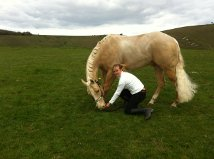
CARROT STRETCH LOW TO THE SIDE
Aims
-
To lift and flex the spine to the side and flex the base of the neck
-
To strengthen core stability and back flexibility
How to perform the exercise
-
Stand next to the horse's ribs level with the girthline
-
Using a treat encourage the horse to bend his head/neck low to the side
- Hold the stretch before allowing the treat to be taken
- Gradually increase the stretch over a few days
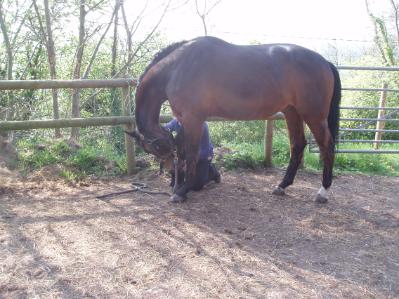
CARROT BETWEEN FRONT LEGS
Aims
-
To lift and flex the withers, neck and back
-
To increase core stability, topline muscle strength and back flexibility
How to perform the exercise
-
Using a treat encourage the horse to bring his head down and back between his legs.
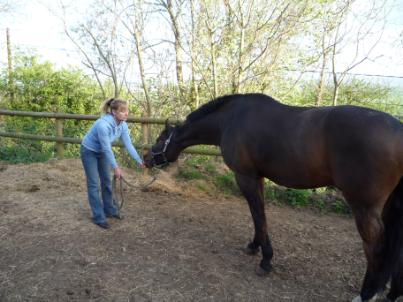
NECK EXTENSION
Aims
-
To stretch the neck muscles by encouraging the horse to stretch forward
-
Stimulates core muscles as the horses reaches forwards
-
Promotes good posture and vertebral alignment
-
Reduces stiffness and encourages the horse to stretch long and low
How to perform the exercise
- Perform from inside the stable with a low chain or rope over the door until the horse understands the exercise
- Use a treat at or below the level of the sternum and encourage to stretch
Photographs to show thoracolumbar spine before lift and with sternum / abdominal lift.
STERNUM / ABDOMINAL LIFT
Aims
- To stimulate the abdominal and thoracic sling muscles
- To be able to support the weight of the rider
How to perform the exercise
- Stand facing the girth line, stroke the horses sternum
- Then apply upward pressure with your finger tips to encourage back to lift
- The horse will gently lift up at the withers and thoracic spine
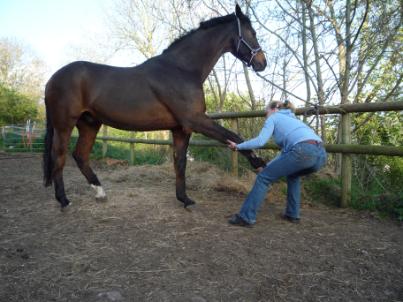
FORELIMB PROTRACTION STRETCH
Aims
-
To stretch the triceps, latissimus dorsi muscles and forelimbs running down the back of the legs
-
Improves range of movement and stride length
How to perform the exercise
-
Perform when the horse is warm ie. following work
-
With your knees bent and your back straight stand in front of the horse and hold the back of the fetlock and the forelimb
-
Bring the leg forwards to encourage the stretch
-
Aim to hold the stretch for approximately 15 seconds and then lower the leg so that the opposite hindlimb is seen to lift slightly but still remains on the ground
INTERCOSTAL AND ABDOMINAL OBLIQUE MUSCLES LATERAL THORACIC STRETCH
Aims:
-
To stretch the intercostal and abdominal oblique muscles
How to perform the stretch
-
Stand at your horse's side behind the shoulder, facing the ribcage.
-
Hold the lead rein in one hand while your other hand, fingers pointing upwards, is on the horses ribcage, more or less in the girth area.
-
Push the ribcage over very slowly with the palm flat.
-
Hold for 5 - 15 seconds
-
Use the rein to prevent the horse from stepping forwards or sideways out of the pressure.
-
Do not push too hard or fast or you will disturb the horse's balance and he will move out of the stretch.
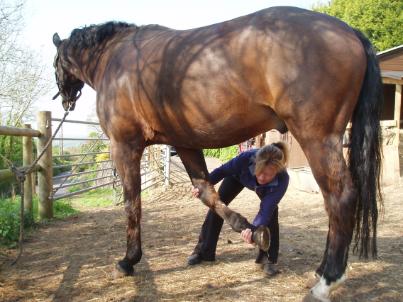
FORELIMB RETRACTION STRETCH
Aims
- To stretch the shoulder muscles used in protraction of the foreleg such as the biceps, pectorals brachii and brachiocephalic muscles
- To improve stride length and reduce muscle stiffness
How to perform the exercise
-
Hold the leg above the knee and on or above the fetlock joint
-
Encourage the horse to gently extend his forelimb towards the hindleg
-
Take care to bend your own knees and keep your back straight
SHOULDER LIFT
Aims:
-
To lift and stretch the shoulder
-
To improve range of the shoulder and forelimb movement both in protraction and retraction
How to perform the stretch
-
Perform when the horse is warm
-
With your knees slightly bent and your back straight, place the right hand well underneath the elbow and the left hand over the front of the cannon bone
-
Gently lift the shoulder straight up and you can feel the shoulder lift
H
HIND LIMB RETRACTION STRETCH
-
To stretch the muscles involved in protraction of the hind leg
-
To increase stride length and reduce muscle stiffness behind
How to perform the exercise
-
With your knees bent and your back straight, stand slightly to the outside of the horse ( to reduce possibility of being kicked), firmly hold the front of the fetlock and the front of the cannon bone.
-
Slowly ask for a hindleg stretch and gradually increase the stretch
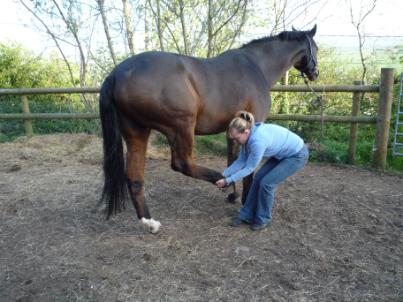
HIND LIMB PROTRACTION STRETCH
Aims
-
To stretch the muscles involed in retraction particuarly the hamstrings
-
To improve range of movement including stride length, proprioception and reduce stiffness..
How to perform the exercise
-
Perform when the horse is warm.
-
With your knees bent and back straight lift the hind limb securely around the fetlock Gently encourage the horse to move the limb towards the back of the knee.
-
Hold the position for approximately 10 to15 seconds and then ask for a little more stretch.
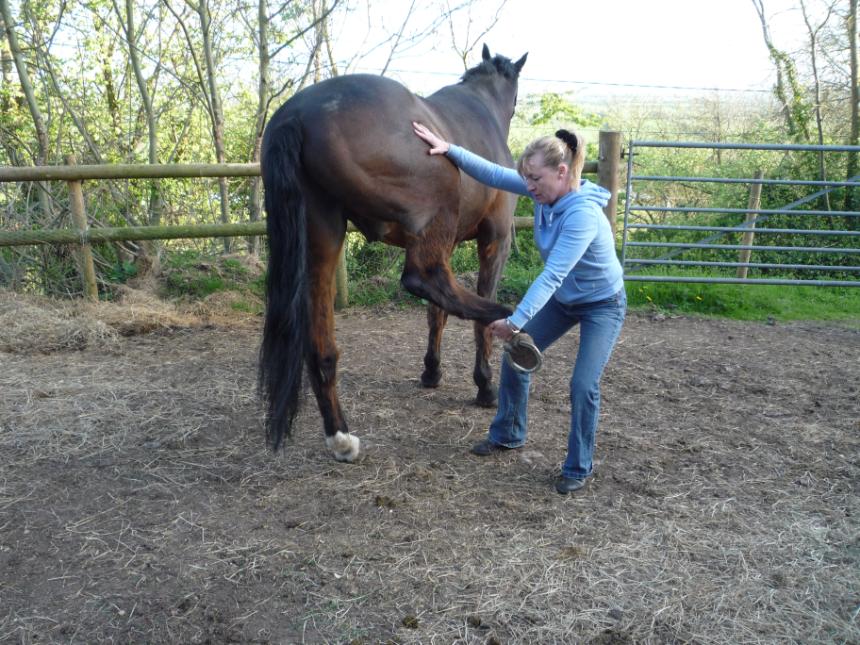
HINDLIMB ADDUCTOR STRETCH
Aims
- To stretch and strengthen the adductor muscles which are very important for stepping through in pirouettes, rollbacks and spins.
How to perfrom the exercise
- Perform when the horse is warm
- Stand facing the back of the horse
- Hold the back of the fetlock with your left hand, bend your knees and place the palm of the right hand over the quadriceps muscles and gently lift the limb outwards.
- Gradually increase the stretch over several days.
- Do not perform this exercise if you feel your horse may kick
MASSAGE
Massage is the manipulation of soft tissues for therapeutic purposes. It has been practised in China for thousands of years. It is a hands-on therapy which is performed by the use of external pressure, influencing the mucles below. Before contemplating givng a massage it is useful to have a basic understanding of anatomy.
When to give a massage
- Give as part of a daily routine
- Give pre and post-exercise
- Give as part of a rehabilitation programme
- A 6 monthly check-up by your therapist is worth considering
Contraindications
Massage is a safe form of therapy but there are some conditions where the application of massage should not be used.
- In the presence of acute inflammation/haemorrage immediately following injury.
- When the animal is dehydrated
- In the presence of infection or a raised temperature
- Skin irritations, fungal or bacterial skin infections
- Over an open wound
- Over fracture sites
- In cases of colic or Azoturia
- Tumours or cysts
Why should a massage be beneficial
- Helps to relieve discomfort, muscle tension and exercise soreness
- Can help with performance and increase range of movement
- Depending on the type of massage can relax or stimulate the muscles
- Aids waste product removal from muscles
- Increases blood flow, oxygen and nutrients to the area
- Helps to breakdown scar tissue and adhesions
Massage techniques
It is essential that the animal accepts you prior to commencing massage therapy. Allow him to smell, lick and generally investigate you. Stroke the animal before you start the massage so that he may become accustomed to your touch. Do not rush when you give a massage. Always massage towards the heart or follow the direction of the hair.
Effleurage (stroking)
All massage sessions should start and end with effleurage. This helps to warm the muscles, enhances drainage and relaxes the animal. Effleurage also encourages the natural release of endorphins hich provides the body with its own pain relief. The use of hotties such as a hot water bottle covered with a pillow case to warm the tissues in cold weather prior to commencing a massage is useful.
- Effleurage strokes should be commenced using a firm but light pressure over the soft tissues gradually increasing pressure.
- Effleurage can be performed with both hands at the same time or in a continuous motion one hand after the other with hands moulding to the underlying contours.
- Do not massage over boney areas such as the spine, ribs, abdomen and the underside of the neck.
Petrissage (compressions)
Petrissage is given to mobilise the tissues and improve the circulation. Petrissage can be applied by kneading or wringing
- Wringing is difficult to perform on a horse and is only really possible on the hamstrings and crest of the neck. Using 2 hands the tissue is grasped. One hand moves the tissue towards you and the other moves the tissue away. The tissue is held for a few seconds and then slowly released.
- Kneading can be executed with one or two hands using a clenched fist or an elbow.
Tapotement (percussion)
Tapotment is used to stimulate the tissue. There are two main ways of performing tapotement
- Clapping, where the hands are cupped, so as not to slap the tissue and are rapidly and alternately applied to the skin. Wrists should be relaxed.
- Hacking involves using the sides of the hands to stimulate the skin, nerves and underlying muscle mass. It is important to keep the wrists, hands and fingers loose.
Example of effleurage strokes
Example of Petrissage strokes
Example of hacking over superficial gluteal muscles
